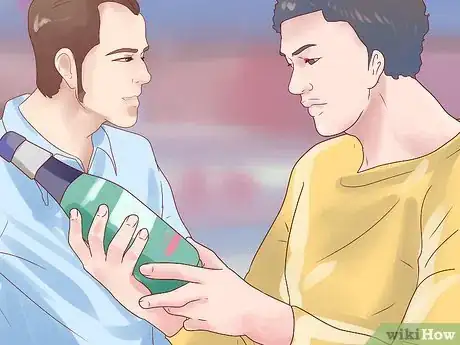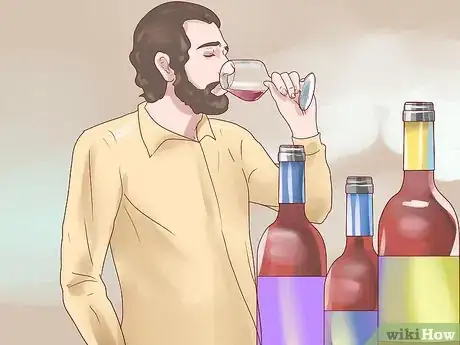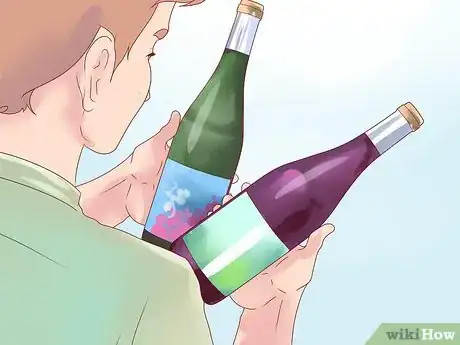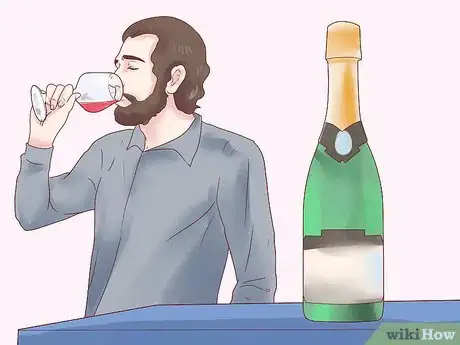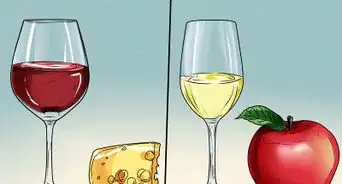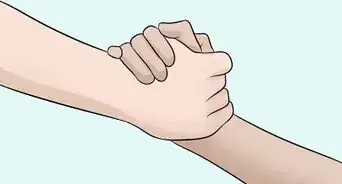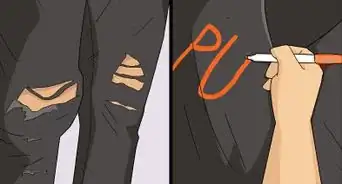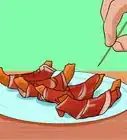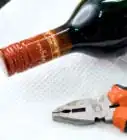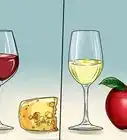This article was co-authored by Murphy Perng. Murphy Perng is a Wine Consultant and the Founder and Host of Matter of Wine, a business that produces educational wine events, including team-building experiences, networking events, and private parties. Based in Los Angeles, California, Murphy has served as a Wine Educator for clients such as Google, Buzzfeed, Tiktok, Snapchat, and Equinox and been featured on National Geographic and The Somm Journal. Murphy possesses her WSET (Wine & Spirit Education Trust) Level 3 Advanced Certification.
There are 11 references cited in this article, which can be found at the bottom of the page.
wikiHow marks an article as reader-approved once it receives enough positive feedback. In this case, several readers have written to tell us that this article was helpful to them, earning it our reader-approved status.
This article has been viewed 342,917 times.
If you're an oenophile (a lover of wine), you're probably wondering what's keeping you from becoming a true connoisseur. Luckily, you don't have to be a wine-maker or have a basement cellar in order to appreciate fine wine. With a notebook and a few bottles handy, you'll be well on your way.
Steps
Building Your Wine Know-How
-
1Drink wine with the 4 S's in mind. Even if you don't know much about wine, you probably know that there's a certain way you're supposed to drink it. Truly, you can drink it however you want – but to get the most out of its aroma and taste, a legitimate art has been formed. Here are the basics in four steps:
- See it. Examine the color. If it's older, a white will be darker and a red will be lighter (by and large). The color can also tell you a bit about the aging processed use. A Chardonnay, for example, will be more golden if aged in oak barrels.
- Swirl it. Coat the sides of the glass by swirling the wine around gently. This releases the aroma, helping you truly taste what's in front of you.
- Smell it. If it's white, look for citrus-y or tropical notes, like lemon and lime, or even melon. You may also be able to detect vanilla or oak. Generally speaking, cooler places produce more citrus-y, tangy wines. If it's red, look for berry or plum scents. Cooler places will fall on the red berry side of the spectrum (like strawberry and cherry), while warmer places will showcase darker scents, like blackberry or plum. You'll also find coffee, smoke, and chocolate as major contenders.
- Sip it. This will be a combination of taste and smell. As you sip it, simply ask yourself whether or not you like it. Then you can move onto why.
-
2Know your tannins and terroir. Oenophiles and connoisseurs will throw around the term "tannin." This is a textural element of wine that makes it "dry." Try a very "dry" wine, and you'll get the sense for what this word means (obviously any liquid isn't actually dry). Tannins are naturally occurring in grapes (and bark and wood and leaves, actually) and they add a bitterness, astringency, and complexity to a wine's flavor. For the record, this applies mostly to red wines.[1]
- "Terroir" is basically the wine's background – the climate and soil type of where it was grown, the topography, and what other plants were growing in the area. This largely influences the grapes. After all, some wines (American) are bottled by grape, sure, but others (European) are bottled just by region. Terroir is what makes a wine, well, itself.
Advertisement -
3Get your temperatures right. Each type of wine should be served at a slightly different temperature for its best taste to surface. Here's what you should know before you throw that wine-tasting gala and invite all your friends over to your house:[2]
- Red wine should be served between 59–64 °F (15–18 °C)
- Pink or rosé wines should be served slightly chilled around 44–55 °F (7–13 °C)
- White wine and sparkling wine should be kept in the wine fridge between 43–50 °F (6–10 °C)
- After that wonderful wine-tasting party, make sure to drink light wines (less alcohol, around 11%) 3 days after opening. Bolder wines are fine for consumption up to a week.[3]
-
4Use the right glass. Each type of wine does best in a certain size and shape of glass to open up their aroma to the fullest. To do your wine justice, put it in the right glass:[4]
- A standard wine glass will do well for most reds. A Cabernet Sauvignon should have a slightly taller, narrower bowl, and make sure your Pinot Noir pour is just an ounce or two.
- White wines are also good in standard glasses – but Chardonnay needs a slightly wider brim.
- A Port needs to be in a large flute; Madeira should be in a large hock glass; Sherry is best in a narrow martini-esque glass.
- Vintage sparkling wines are best in a coupe, tulip, or flute.
-
5Know how to hold the glass, too. You will never be mistaken for a wine connoisseur if you're holding your glass incorrectly. To look like an expert, holding and swilling wine like it's your job, make sure to hold the glass by its stem. This goes double for white wines that are chilled – you don't want the heat of your hands warming the bowl, altering the taste.
- To swirl the wine around the bowl, rotate at your wrist, not your entire arm.[5] The smell of the wine will then fill the bowl of the glass, opening up its flavor profile.
-
6Familiarize yourself with how to describe a wine's aroma. Being a wine connoisseur is mainly about being able to describe what you're tasting and recognize what's happening on your palette. To get at a wine's aroma, there are generally five categories: fruity, mineral, dairy and nutty, sweet and wooden, and spicy and savory. Here's what "flavors" fall under each:[6]
- Fruity. Pretty much any fruit, including the aroma of jam
- Mineral. Flint, stones, earthen, gasoline
- Dairy and nutty. Butter, cream, yeast, bread, toast, grilled nuts, biscuits, almonds
- Sweet and wooden. Chocolate, toffee, butterscotch, honey, vanilla, oak, and cedar
- Spicy and savory. Tobacco, smoke, licorice, pepper, truffles, bacon, coffee, cinnamon
Cultivating a Taste
-
1Go to a wine shop and ask the staff for recommendations. Look for bottles of wine with write-ups near them, award citations and high magazine ratings. Try to go when you know the store is holding a tasting with samples – for many, this is on Saturday mornings. Pick the staff's brains – what are their favorites and why?
- Come in with a meal plan in mind. That way you can buy wines that match the taste of the food you're serving and start exploring combinations. As a rule of thumb, red wines go with red meat; white wines go with white meat. And champagne goes with just about everything, but master the basics first.
-
2Attend a local wine tasting or a wine appreciation class. These are held at adult schools, wine-making schools, wineries, and fine restaurants. Don't feel intimidated – many people who think they can distinguish between a $2 bottle of dirt and a nice vintage often can't.
- If you visit a winery, make time to go in for more than just the tasting. You'll learn how wine is made, see how the grapes are grown and be taught the proper procedure for drinking wine.
-
3Join a wine group. Wine is trendy. There are wine bars, wine stores, wine newsletters, and even wine podcasts. Finding a group of wine-lovers in your area is probably much easier than you think it is. Finding like-minded people who have connections and know what's going on in the area is the first step to developing your expertise.
- Most groups have individuals at all levels – from those that want to buy their own winery to those who just like drinking wine. There will be a place for you in yours.
-
4Have an informal tasting at home, a friend's house, or a BYOB restaurant where each person brings a different bottle of wine. This way you can taste a bunch of different things without spending a lot of money. And, not to mention, you get a great deal of wine experience (and wine!).
- Make sure you have palette cleansers to munch on or drink between sips. Stick to bland crackers (like water crackers) or bread (a plain french loaf; nothing grainy) and water. Graber olives and rare roast beef are also sometimes used. Stay away from cheeses and fruits that are normally served with wines, as those will mask the true flavor of each.
-
5Buy a notebook (or get the app for that). Now that you're about to be fully immersed in the wide world of wines, get something to remember your experiences with. This could be as simple as a notebook and pen or an app on your phone (search for "wine diary" or something similar). This way you remember which bottles you love, which you hate, and the characteristics of each wine you run across.
- Some websites like Cellartracker are community based.[7] You can then share and compare notes with other oenophiles and dive head-first into the cyber wine-loving community, too.
Developing Your Palette
-
1Start exploring wine varieties. Many people start with a fruity white white that is subtle in flavor and some happen to stop there. You probably have a couple of wines that you know are safe – so start branching out! Move onto rose wines, and start busting into reds with a vengeance. Even if you don't like it, now you know if you like it or not.
- Not only should you switch up varieties, but switch up brands and years, too. Just because you dislike one producer's Chardonnay doesn't mean you won't like another's. Every wine is unique – and it can depend on your mood, too.
-
2Find your "Aha!" wine. Plenty of people spend years in the realm of, "Oh, I don't really care for robust reds," or "Moscato is just too sweet," and their expertise and understanding stops there. And then bam – an "aha" wine hits. It's that wine where you can actually taste the cedar, or the smoke, or the chocolate. All of a sudden, you get it. And how do you find your "aha" wine? Trial and error.
- And an "aha" wine doesn't have to be good or, rather, one you enjoy. It simply has to be one where all of a sudden your palette gets it. It can sort out the variety of aromas in a single glass and knows what it likes and dislikes and better yet, why.
-
3Start researching. Now that you've got your feet wet, start going outside of your own circle for information. Read books and blogs on wine. Try The New Sotheby’s Wine Encyclopedia by Tom Stevenson or wineeducation.com, where you can even take quizzes on your growing wine knowledge.[8] Purchase wine guides. Subscribe to wine magazines. The possibilities are almost endless.
- Subscribe to free, informative online wine newsletters. Do a quick Google search for reputable websites that are devoted to building a community of wine lovers.
- GrapeRadio is a podcast devoted to wine – even in the midst of rush hour, you could be honing your skills.
-
4Get bolder and bolder. So you've got the taste of a Pinot Grigio down. You know the difference between a good Merlot and a good Cabernet. But there's so much more to it than that. You've done the basics, so let's get bold. Here's a few to try:
- Syrah / Shiraz
- Malbec
- Petite Sirah
- Mourvedre / Monastrell
- Touriga Nacional
- Cabernet Sauvignon
- Petit Verdot
Becoming a True Connoisseur
-
1Start widening your "wine-describing" vocabulary. The difference between someone who loves wine and someone who is a wine connoisseur is largely the fact that they can confidently talk about it to others (and accurately, to boot). Here's a few goals to hit when describing your next few glasses: [9]
- You can name more than 2 fruits as flavors in the wine
- You can name more than 3 other characteristics such as cinnamon, oregano, roses, chalk or baking spices
- The palate of the wine changes from the moment you taste it to the moment you swallow, and you can identify how
-
2Try sparkling wines, ice wines and dessert wines. You've gone bold, now let's go a bit off the main path: try other wines, like sparkling, dessert, and ice wines (ice wines are made from grapes that have experienced a frost). They're not the wines you'll be experiencing with a main course at a 5-star restaurant, but they're important nonetheless.
- Experience wines from a variety of countries and various locales, such as a New Zealand and British wines, or wines from South Dakota and Idaho. Don't just stick to Californian wines or European wines – even when it comes to sweet, dessert wines.
-
3Learn about different grape varieties. Traditionally fine wine was made from mainly French grape varieties, but now a much wider range of grape varieties are being used. Wineries are popping up all over the place, and the "terroir" of your average grape is changing. How do you feel about each region and variety?
- France, Italy, Spain, China,Turkey, and the US are the main producers of wine (though they are by no means the only), and each have specific varieties of grapes that are able to grown in their respective regions.[10] Because of this, wines from different areas of the world will taste different. What's your take on them?
-
4Go back to the basics. Now that you're a world traveler when it comes to wine, go back to the very first wines you tried. There will be such difference you'll wonder who the person was that tasted it originally, or how it's possible the wine has completely morphed – but it's undeniable that it has. Take that basic Chardonnay that's been sitting in your cupboard and take a sip, basking in your progress.
- It'll become evident to you how much your palette has changed. It'll also become evident which wines you love and which you won't even bother trying anymore. For a real challenge, get blind taste-testing glasses and see if you remain consistent.
-
5Look for a wine school in your area. Most host courses or tastings, offering you some sort of "certificate" or "accreditation" upon finishing. Local adult schools and restaurants also hold wine appreciation classes. When people ask if you know wine, you can mention that you've even studied it.
- Though, for the record, just like anything else, you don't need school to become a connoisseur. It's just an easy way to prove that you know your stuff.
-
6Take the Court of Masters test. In America, to be a master sommelier, you need to take the Court of Masters test. There's a course you can take (you have to apply), though you can take the test without taking the course. This is as high as you can get in the wine world – and it comes with quite the badge of respect.[11]
- They also offer international courses. Currently there are only 140 Master Sommeliers in North America. Ready to be the next?
Expert Advice
When you're learning about wine...
- Drink it often: The most important thing you can do to learn about wine is to just to taste it. You can read a lot, but a book will never be able to tell you exactly what a wine tastes like. You really have to see that for yourself.
- Read about the winemaking process: You have to understand a lot of different things to understand wine. Try reading a comprehensive book on the winemaking process. Ideally, it should cover everything from harvesting the grapes to fermentation to post-fermentation aging, but it should also discuss factors like the climate, the soil, and the water.
- Learn about different regional wines: The major wine regions are divided into the Old World, which is Europe, and the New World, which includes the US, Australia, Chile, New Zealand, and so on. All of these places have different winemaking processes, and they even have different legislation that might affect how the wine turns out, like regulations on what kind of grapes can be used or how much alcohol can be in the wine. Understanding that will help you understand what flavors to expect from your wine.
Community Q&A
-
QuestionWhat is a wine expert called in a restaurant?
 HumanBeingTop AnswererA sommelier, or wine steward, is a trained and knowledgeable wine professional, normally working in fine restaurants. The sommelier specializes in all aspects of wine service, as well as wine and food pairing.
HumanBeingTop AnswererA sommelier, or wine steward, is a trained and knowledgeable wine professional, normally working in fine restaurants. The sommelier specializes in all aspects of wine service, as well as wine and food pairing.
Warnings
- Don't be afraid to get started. No one was born knowing all about wine; jump right in and get your feet wet.⧼thumbs_response⧽
References
- ↑ http://www.businessinsider.com/everything-you-need-to-know-about-wine-2013-8#ixzz3E5USpUru
- ↑ http://www.businessinsider.com/everything-you-need-to-know-about-wine-2013-8
- ↑ http://www.businessinsider.com/everything-you-need-to-know-about-wine-2013-8#ixzz3E5TsCka1
- ↑ http://winefolly.com/tutorial/types-of-wine-glasses/
- ↑ http://www.businessinsider.com/everything-you-need-to-know-about-wine-2013-8#ixzz3E5Tgd8cM
- ↑ http://visual.ly/beginners-guide-wine
- ↑ http://www.cellartracker.com
- ↑ http://www.wineeducation.com
- ↑ https://winefolly.com/deep-dive/becoming-a-wine-expert/
- ↑ J. Robinson, ed. The Oxford Companion to Wine, Third Edition p.719; Oxford University Press, 2006, ISBN 0-19-860990-6
- ↑ http://www.mastersommeliers.org/
About This Article
To become a wine connoisseur, start by paying attention to the color, aroma, and taste of the wine as you sip it, and try to notice what makes it unique. Also, make sure you learn the various wine aroma terms like fruity, mineral, and spicy, so you can appropriately describe the wines you're tasting. Then, to keep track of the wines you’ve tried and what you’ve learned, download a wine diary app for your phone or keep a small notebook handy. As you learn more, try visiting websites like wineeducation.com, where you can take quizzes to test your knowledge about wine. For tips on how to use all your senses when tasting a wine, read on!






